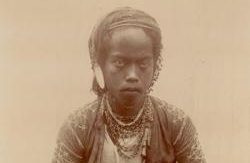I first got interested in Bagobo warrior culture after interviewing Master Yuli Romo, a senior student of the late Grandmaster Antonio “Tatang” Illustrisimo in 2003. Prior to our meeting, I have seen Romo in pictures wearing a Bagobo costume. Of all the Filipino martial arts (FMA) masters I have met, Romo has the most distinct aura of ethnicity. During the interview, he demonstrated a Bagobo salutation wherein the sword is held at the back.
Warrior tribe
The Bagobos are one of the non-Muslim ethnic minority groups in Mindanao originally inhabiting the west coast of Davao. Similar to Muslim society, the Bagobos of old were divided into datus or the chieftains, freemen, and slaves. They however worshipped spirits called “gimokods” whose knowledge lives in their elders called “mabalians.”
A vivid portrait of the Bagobos, long before many of them converted to Christianity was captured in the book “The Wild Tribes of Davao District, Mindanao” by American anthropologist Fay-Cooper Cole published in 1913.
Cole noted that among the foremost aspirations of Bagobo men was to become warriors, “Young men strived to attain the rank of magani, a warrior class whose members had killed more than one enemy and were entitled to wear distinctive red clothing.”
Cole commented on how strife was born between the Moros and the Bagobos, he wrote, “The friendly relations with the Moro seem to have been broken off upon the arrival and settlement of the Spaniards in Davao. The newcomers were then at war with the followers of Mohammed and soon succeeded in enlisting the Bagobo rulers in their cause.
A Chinese plate decorated with the picture of a large blue fish was offered for each Moro head the tribesmen presented to the Spanish commander. The desire for these trophies was sufficient soon to start a brisk trade in heads, to judge from the number of these plates still to be seen among the prized objects of the petty rulers.”
Either alone or in a group, it is interesting to note the Bagobos’ courage in entering hostile territories to conduct raids. Those aspiring the status of a magani conducted ambushes on passing foes.
Raids were also conducted by croups consisting of 60 or more men under the leadership of a magani. The reasons for such raids vary like avenging a death of a fellow tribesman, securing loots and slaves or to get glory and recognition.
During these operations, The Bagobos used an implement of war called “sogiang,” which are sharpened bamboo sticks that were stuck on the ground to wound patrolling or pursuing enemies.
Cole described the cherished trophies of the Bagobo warriors with the following words, “The warriors of Cibolan and Malilla formerly carried heads of enemies to their towns and made use of them during the GinEm ceremony, while at Bansalan and Digos a lock of hair, cut from the head of the slain, answered the same purpose.
Individual raiders sometimes carry home a head or a hand as evidence of a successful fight, and at such times festivals may be held to celebrate the event. However, the trophy soon loses its value and is hung or buried at a distance from the village. Head-hunting for the sake of the trophy itself, does not exist here.”
Unique armor
Like other tribal groups in the Philippines, the native weapons of the Bagobos are swords and knives for close quarter combat and spears, bows and arrows as well as blowguns for long-range fighting. But what is most unique about the Bagobos is the type of armor they use and how it affected their fighting strategy, on this Cole wrote, “For defense they carry shields, either round or oblong and cover the body with so many strips of hemp cloth that a knife thrust is warded off.
Turning his body sideways to the enemy, the warrior crouches behind his shield, keeping up a continuous capering, rushing forward or dancing backward, seeking for an opening but seldom coming to close quarters.
Arrows and spears are glanced off with the shield. An attack is usually initiated by the throwing of spears, then, if the enemy is at a disadvantage or confused, the warriors rush in to close combat. For this purpose they rely entirely on their knives, and as fencers they are unexcelled.
They are but indifferent shots with the bow and arrow, and that weapon is but little used in actual combat. It has been frequently stated that these arrows are poisoned but I was unable to discover a single specimen so prepared.”
Besides hemp, Cole also mentioned two materials commonly found in the Philippines – carabao horn and rattan, which the Bagobos used in constructing armor, “Old warriors state that in former years they not only covered the upper part of the body with hemp cloth but wound over this long decorated strips called gindua; they also tell of coats of mail made of carabao horn or rattan.
None of these outfits exist in the territory today, but it is not at all improbable that they were formerly in use, for the long decorated bands are still found among the Bukidnon of the North, with whom some trade is carried on; and a few coats of mail are to be seen among the neighboring Moro.”






















